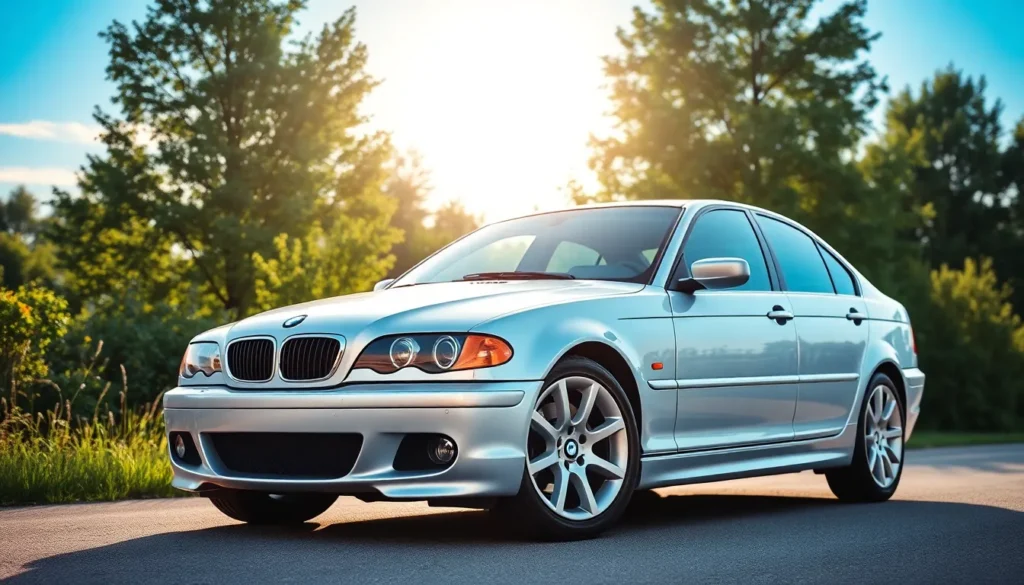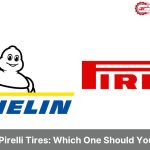We’ve witnessed countless automotive legends come and go but few vehicles have captured enthusiasts’ hearts quite like the BMW E46 sedan. This fourth-generation 3 Series represents the perfect marriage of German engineering precision and driving dynamics that defined an entire era of luxury sport sedans.
From 1998 to 2006 the E46 sedan dominated roads worldwide with its distinctive kidney grille timeless silhouette and near-perfect 50/50 weight distribution. Whether you’re considering purchasing one or already own this automotive masterpiece understanding its unique characteristics becomes essential for maximizing your ownership experience.
We’ll explore everything that makes the E46 sedan special—from its legendary inline-six engines to common maintenance considerations that keep these machines running strong decades later. This comprehensive guide will help you navigate the industry of E46 ownership with confidence.
BMW E46 Sedan Overview and Specifications
The BMW E46 sedan represents the fourth generation of BMW’s 3 Series lineup, showcasing the manufacturer’s commitment to precision engineering and driver engagement. This generation established benchmarks for compact executive sedans that competitors still reference today.
Engine Options and Performance
Four distinct engine configurations powered the E46 sedan throughout its production run. The base 316i featured a 1.9-liter four-cylinder engine producing 105 horsepower, while the 318i offered a 2.0-liter four-cylinder with 143 horsepower. Mid-range variants included the 320i with a 2.2-liter inline-six generating 170 horsepower and the 325i equipped with a 2.5-liter inline-six producing 192 horsepower. Performance enthusiasts gravitated toward the 330i, which housed a 3.0-liter inline-six delivering 231 horsepower and 221 lb-ft of torque.
| Model | Engine | Horsepower | Torque (lb-ft) | 0-60 mph |
|---|---|---|---|---|
| 316i | 1.9L I4 | 105 | 129 | 11.9s |
| 318i | 2.0L I4 | 143 | 147 | 9.8s |
| 320i | 2.2L I6 | 170 | 181 | 8.7s |
| 325i | 2.5L I6 | 192 | 206 | 7.4s |
| 330i | 3.0L I6 | 231 | 221 | 6.5s |
Manual transmissions came standard across most variants, with BMW’s five-speed Getrag unit providing precise gear changes. Automatic options included a four-speed or five-speed ZF transmission depending on the model year and engine choice.
Interior Features and Comfort
German craftsmanship defines the E46 sedan’s cabin with premium materials and ergonomic design elements. Standard equipment included power windows, central locking, and air conditioning across all trim levels. Higher specification models featured leather upholstery, heated seats, and automatic climate control systems.
Dashboard layout prioritizes driver accessibility with controls positioned within easy reach. The instrument cluster displays essential information through clear analog gauges, while the center console houses audio and climate controls. Rear passengers enjoy adequate legroom and headroom even though the sedan’s compact dimensions.
Technology features varied by model year and trim level. Later production models incorporated navigation systems, premium audio packages, and enhanced safety equipment including multiple airbags and stability control systems.
Exterior Design and Styling
Chris Bangle’s design team created the E46 sedan’s distinctive silhouette that balanced sporting character with executive presence. Clean body lines flow from the signature kidney grille through pronounced wheel arches to the integrated rear spoiler. Chrome accents on window trim and door handles provide subtle luxury touches.
Xenon headlights became available on higher trim models, offering superior illumination compared to standard halogen units. Wheel options ranged from 15-inch steel wheels on base models to 18-inch alloy designs on performance variants. Paint choices included metallic options like Steel Blue and Orient Blue alongside solid colors such as Alpine White and Jet Black.
Aerodynamic elements include front air dams and rear diffusers that reduce drag while improving the sedan’s athletic stance. Body cladding remains minimal, allowing the E46’s proportions to speak for themselves without unnecessary decoration.
Driving Experience and Handling
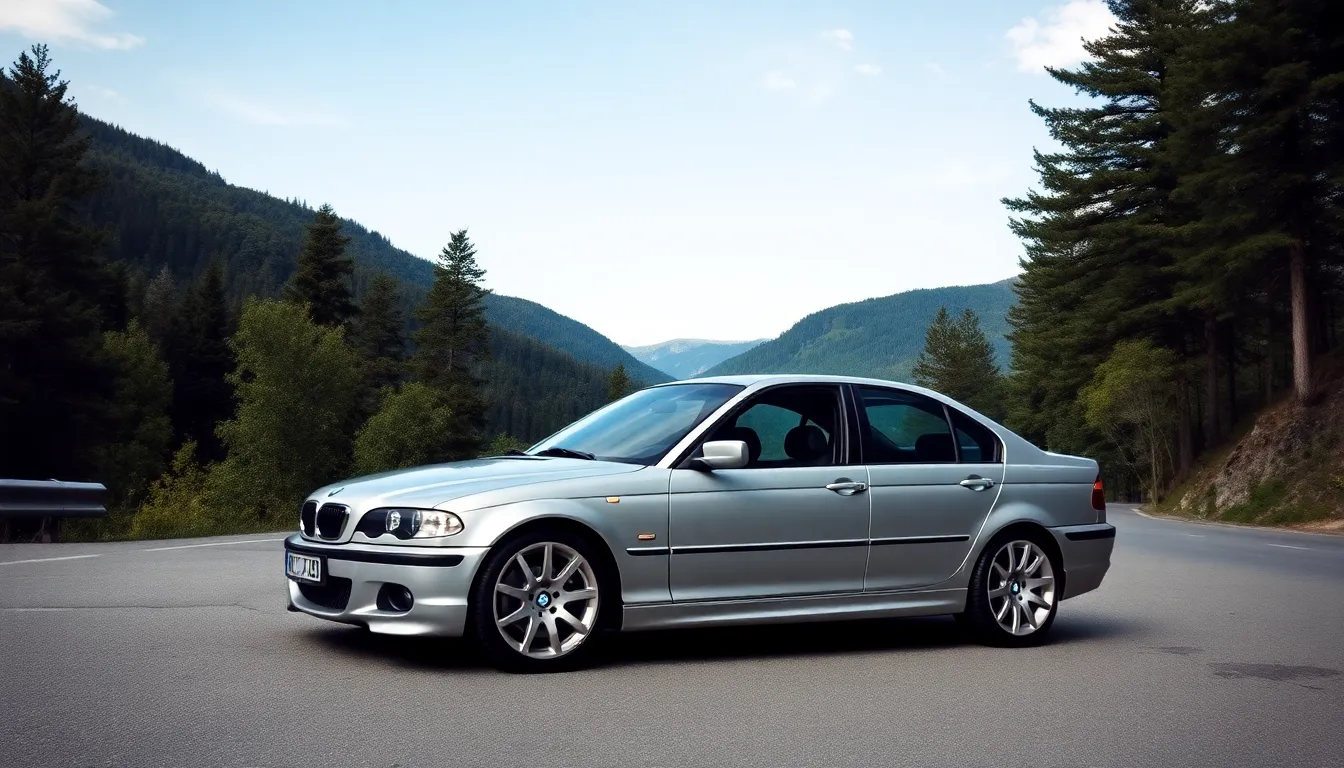
The BMW E46 sedan delivers a driving experience that exemplifies the brand’s ultimate driving machine philosophy. Its exceptional handling characteristics stem from precisely engineered suspension geometry and optimal weight distribution.
Road Performance and Dynamics
Road performance in the E46 sedan centers around its sophisticated suspension system featuring MacPherson struts in the front and multi-link independent rear suspension. This configuration provides exceptional cornering stability while maintaining ride comfort across various driving conditions. The 50/50 weight distribution creates balanced handling dynamics that respond predictably to driver inputs.
Steering precision ranks among the E46’s strongest attributes with its recirculating ball power steering system delivering direct road feedback. The steering ratio varies by trim level but consistently provides accurate turn-in response and minimal on-center play. Electronic stability control became standard on later model years, improving safety during aggressive cornering maneuvers.
Braking performance utilizes ventilated disc brakes on all four corners for most variants. The 330i model features larger front rotors measuring 325mm compared to 286mm on base models, providing superior stopping power. ABS comes standard across all trim levels, working along with brake assist to optimize stopping distances.
The chassis rigidity contributes significantly to overall driving dynamics through reinforced A-pillars and strategic body bracing. This structural integrity minimizes flex during spirited driving while reducing noise, vibration, and harshness levels in the cabin.
Fuel Economy and Efficiency
Fuel economy figures vary considerably across the E46 sedan’s engine lineup, with EPA ratings reflecting real-industry efficiency expectations. The base 325i achieves approximately 22 mpg in city driving and 30 mpg on highways when equipped with manual transmission.
| Engine Model | City MPG | Highway MPG | Combined MPG |
|---|---|---|---|
| 325i Manual | 22 | 30 | 25 |
| 325i Automatic | 20 | 28 | 23 |
| 330i Manual | 20 | 28 | 23 |
| 330i Automatic | 19 | 27 | 22 |
Manual transmissions consistently deliver better fuel economy compared to automatic variants across all engine options. The 330i sacrifices approximately 2-3 mpg for its additional performance capabilities, making the 325i the efficiency leader in the lineup.
Driving habits significantly impact fuel consumption with aggressive acceleration and high-speed cruising reducing overall efficiency. Urban driving conditions with frequent stop-and-go traffic typically yield lower fuel economy figures than steady highway cruising at moderate speeds.
The E46’s fuel tank capacity measures 16.6 gallons, providing a theoretical range of approximately 415 miles with the 325i manual transmission under optimal conditions. Regular maintenance including clean air filters and properly inflated tires helps maximize fuel efficiency throughout the vehicle’s lifespan.
Reliability and Common Issues

The BMW E46 sedan demonstrates solid long-term reliability when properly maintained, though certain mechanical components require attention throughout its ownership lifecycle. Understanding these patterns helps owners prepare for maintenance expenses and prevents minor issues from developing into major problems.
Known Problems and Answers
Cooling system failures rank as the most frequent E46 reliability concern, with plastic components deteriorating after 80,000 to 120,000 miles. Water pumps develop leaks around their seals, while expansion tanks crack near mounting points and radiator necks become brittle. Replacing the entire cooling system as a preventive package costs $800 to $1,200 but eliminates future overheating risks.
Window regulator mechanisms fail consistently across all E46 variants, typically between 60,000 and 100,000 miles of operation. Plastic clips within the regulator assemblies break, causing windows to drop unexpectedly or operate sluggishly. Aftermarket metal replacement regulators priced at $150 to $250 per door provide permanent answers superior to original BMW parts.
VANOS system complications affect inline-six engines, manifesting as rough idle conditions and reduced power delivery between 70,000 and 130,000 miles. Seals within the variable valve timing system harden and leak, while solenoids become clogged with debris. Complete VANOS rebuilds range from $600 to $1,000 and restore engine performance to factory specifications.
Control arm bushings deteriorate predictably due to rubber compound breakdown, creating handling imprecision and tire wear patterns after 80,000 miles. Front lower control arms with integrated ball joints cost $200 to $300 each, while rear trailing arm bushings require $400 to $600 in labor-intensive replacement procedures.
Maintenance Costs and Schedule
Routine service intervals follow BMW’s established 15,000-mile inspection schedule, with oil changes recommended every 7,500 miles for optimal engine protection. Basic maintenance including oil, filters and fluid checks costs $200 to $350 at independent shops, while BMW dealerships charge $400 to $600 for identical services.
Major service milestones occur at 60,000-mile intervals and include transmission fluid replacement, spark plug renewal and comprehensive brake system inspection. These extensive services range from $800 to $1,500 depending on parts replacement requirements and labor rates in exact geographic markets.
Annual ownership expenses for well-maintained E46 sedans average $1,200 to $2,000 excluding insurance and fuel costs. Higher-mileage examples exceeding 150,000 miles may require $2,500 to $4,000 annually as suspension components and engine accessories reach replacement intervals simultaneously.
| Maintenance Item | Service Interval | Cost Range |
|---|---|---|
| Oil Change | 7,500 miles | $80-$150 |
| Brake Fluid | 24 months | $120-$180 |
| Coolant System | 60,000 miles | $300-$500 |
| Transmission Service | 60,000 miles | $250-$400 |
| Spark Plugs | 60,000 miles | $200-$350 |
Market Value and Ownership Costs
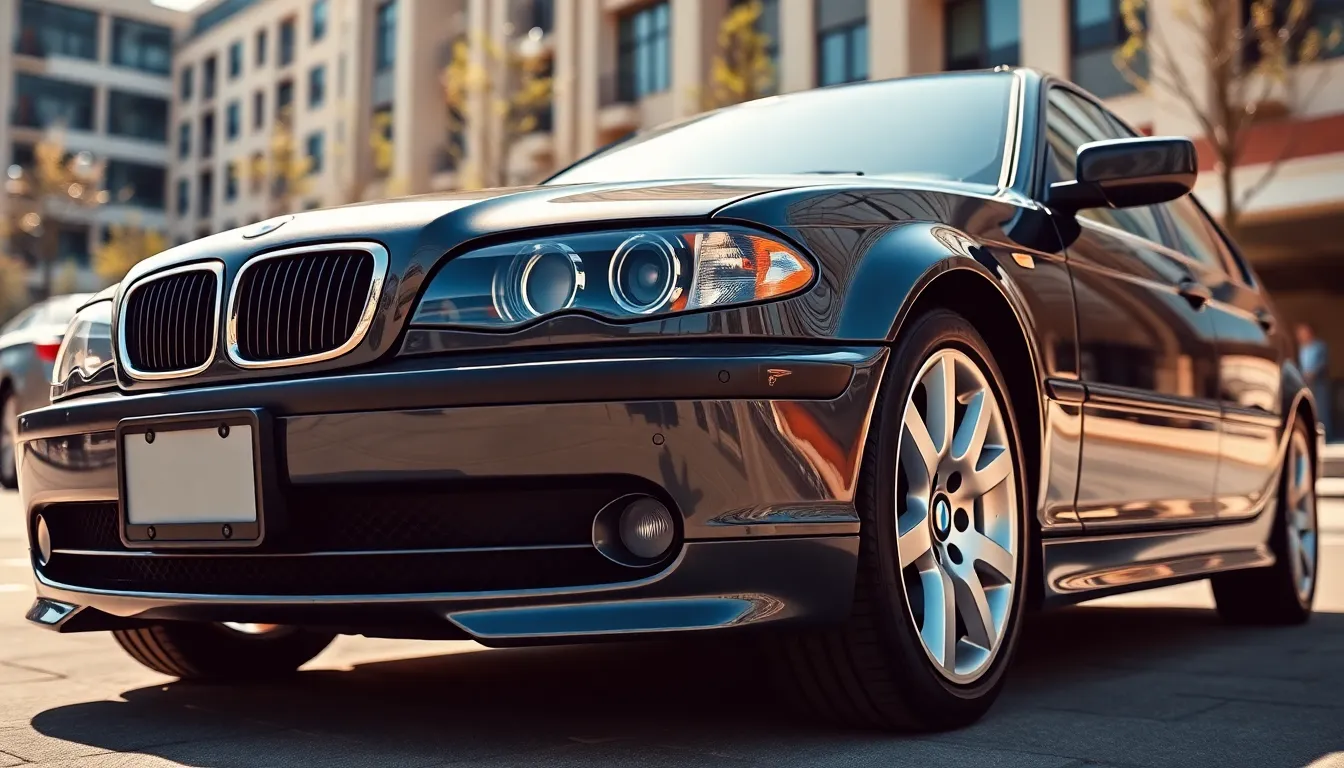
BMW E46 sedan market values reflect the model’s enduring appeal among enthusiasts and practical buyers alike. Understanding current pricing trends and ongoing expenses helps potential owners make informed purchasing decisions.
Current Pricing Trends
E46 sedan market prices vary significantly based on mileage, condition, and engine configuration. Low-mileage 330i models with manual transmissions command $15,000 to $25,000 in excellent condition. Mid-range 325i variants typically sell between $8,000 and $15,000 depending on maintenance history and cosmetic condition.
Base 320i and 316i models offer entry points from $5,000 to $10,000, though higher-mileage examples often require immediate attention to common failure points. Premium packages and sport variants add $2,000 to $5,000 to base values. Manual transmission cars consistently outsell automatics by 15-20% in the current market.
Regional pricing differences show West Coast markets commanding premiums of $1,500 to $3,000 over Midwest equivalents. Rust-free Southern examples maintain value better than Northeast cars exposed to road salt. Documentation of cooling system updates and recent maintenance significantly impacts asking prices.
Insurance and Running Costs
Insurance premiums for E46 sedans remain moderate compared to modern luxury vehicles. Standard coverage costs $800 to $1,400 annually for drivers with clean records. Performance variants like the 330i may increase premiums by $200 to $400 yearly due to higher replacement costs and theft risk.
| Cost Category | Annual Range |
|---|---|
| Basic Insurance | $800 – $1,400 |
| Fuel Costs | $1,800 – $2,400 |
| Routine Maintenance | $1,200 – $2,000 |
| Major Repairs | $800 – $3,000 |
Fuel expenses average $1,800 to $2,400 annually based on 12,000 miles of mixed driving. Premium gasoline requirements add approximately $300 yearly compared to regular unleaded vehicles. Tire replacements occur every 40,000 to 60,000 miles with quality sets costing $600 to $1,200 installed.
Registration and licensing fees remain consistent with other vehicles of similar age and weight. Parts availability through BMW’s Classic program and aftermarket suppliers keeps component costs reasonable. Independent specialist shops typically charge 30-40% less than BMW dealerships for equivalent services.
Pros and Cons of the BMW E46 Sedan
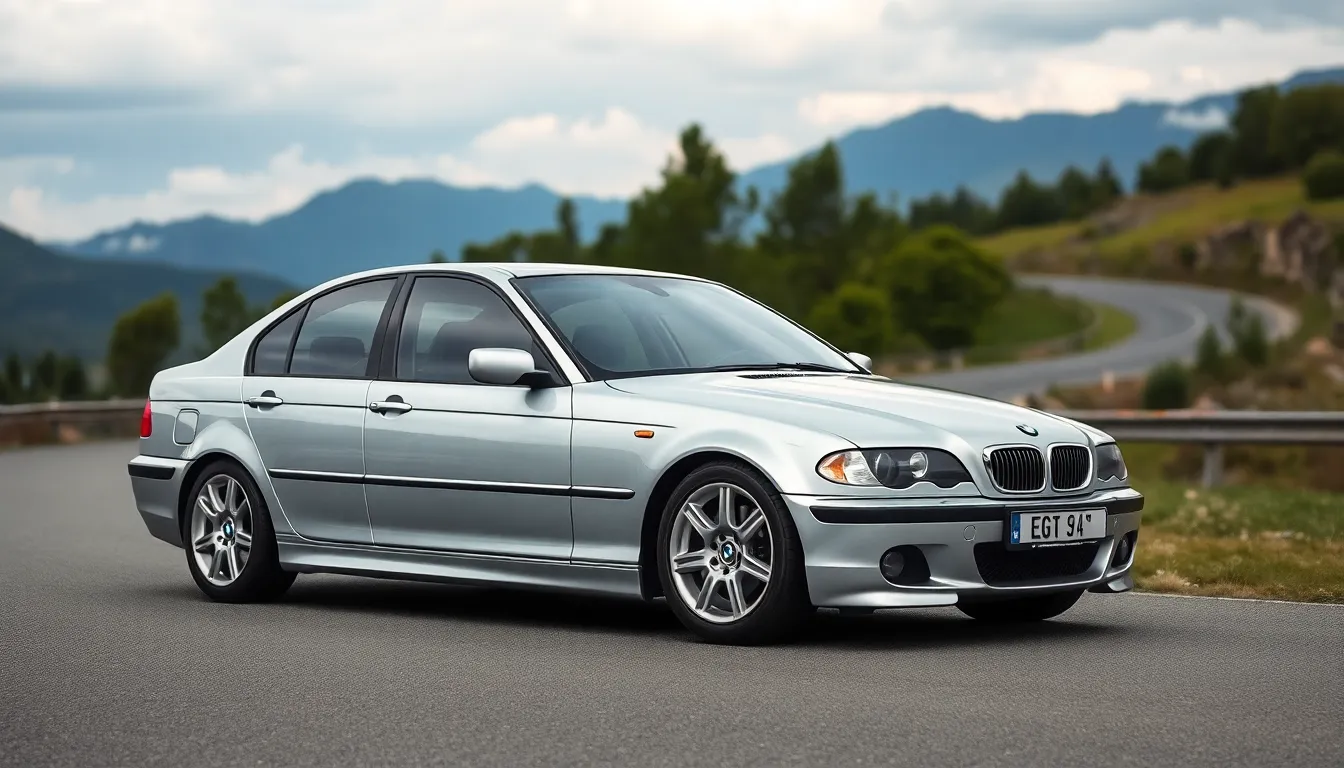
Advantages
Engine Performance Excellence
Our analysis reveals the E46’s inline-six engines deliver exceptional power and smoothness across all configurations. Naturally aspirated engines from 2.2 to 3.0 liters provide reliable performance with minimal turbo lag concerns. Peak torque delivery occurs between 3,500 and 4,500 RPM, offering excellent mid-range acceleration for daily driving scenarios.
Superior Handling Dynamics
Precision steering and balanced chassis engineering create an captivating driving experience that few competitors match. MacPherson strut front suspension and multi-link rear setup deliver exceptional cornering stability while maintaining ride comfort. Weight distribution approaches the ideal 50/50 split, improving overall vehicle dynamics and driver confidence.
Build Quality and Materials
German engineering standards ensure long-term durability when maintenance schedules are followed properly. Interior materials feature premium leather options, solid switchgear, and ergonomic dashboard layouts that remain functional after decades of use. Exterior paint quality and panel gaps demonstrate superior manufacturing tolerances compared to contemporary rivals.
Strong Aftermarket Support
Enthusiast community backing provides extensive modification options and readily available performance parts. OEM replacement components remain accessible through BMW’s heritage parts program and third-party suppliers. Technical documentation and repair guides are comprehensive, supporting both professional mechanics and dedicated DIY owners.
Disadvantages
Cooling System Vulnerabilities
Plastic cooling components deteriorate predictably between 80,000 and 120,000 miles, requiring complete system overhauls. Radiator, expansion tank, and water pump failures create cascading damage if left unaddressed. Preventive replacement costs range from $800 to $1,200 but prevent catastrophic engine damage worth thousands more.
Electronic Component Failures
Window regulator mechanisms fail frequently, particularly on driver and passenger front doors after 100,000 miles. VANOS variable valve timing systems develop internal seal failures that reduce engine performance and create rough idle conditions. Diagnostic costs for electronic issues average $150 to $300 before repair expenses.
Maintenance Cost Intensity
Annual ownership expenses exceed most mainstream alternatives, averaging $1,200 to $2,000 for well-maintained examples. Major service intervals at 60,000 and 120,000 miles cost $800 to $1,500 at independent shops. Genuine BMW parts command premium prices, though aftermarket alternatives reduce some expense categories.
Suspension Wear Patterns
Control arm bushings deteriorate rapidly in harsh climate conditions, creating handling degradation and tire wear issues. Strut mounts and shock absorbers require replacement every 80,000 to 100,000 miles depending on driving conditions. Complete suspension refresh costs range from $1,500 to $2,500 using quality aftermarket components.
Insurance and Fuel Considerations
Performance reputation elevates insurance premiums above economy sedan rates, averaging $800 to $1,400 annually for comprehensive coverage. Fuel economy suffers with spirited driving habits, particularly in city conditions where the 325i achieves only 20 to 22 MPG. Premium fuel requirements add approximately $200 to $400 annually compared to regular gasoline vehicles.
Should You Buy a BMW E46 Sedan?
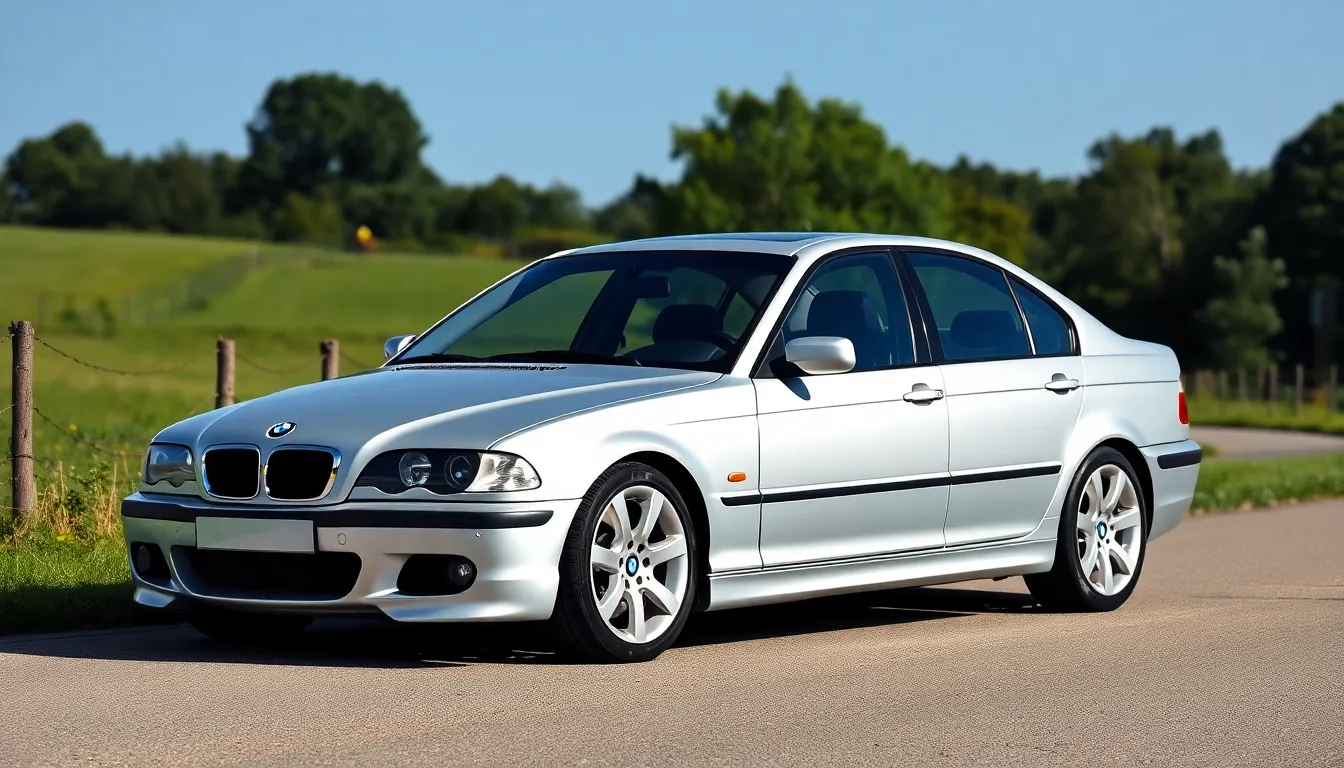
The BMW E46 sedan presents a compelling proposition for enthusiasts seeking German engineering excellence at accessible pricing. Current market conditions favor buyers with well-maintained examples available across multiple price segments from $5,000 to $25,000 depending on condition and configuration.
Financial Considerations for E46 Ownership
Purchasing an E46 sedan requires careful budget planning beyond the initial acquisition cost. Annual ownership expenses range from $1,200 to $2,000 for well-maintained vehicles while higher-mileage examples demand $2,500 to $4,000 annually. Insurance premiums cost $800 to $1,400 yearly with fuel expenses adding $1,800 to $2,400 for mixed driving conditions.
Maintenance costs present the largest ongoing expense category. Routine services at independent shops range from $200 to $350 per visit while major service intervals at 60,000 miles cost $800 to $1,500. Cooling system preventive maintenance requires $800 to $1,200 investment while window regulator replacements and VANOS rebuilds cost $150 to $1,000 each.
Target Buyer Profile
The E46 sedan suits enthusiasts who prioritize driving dynamics over convenience features. Buyers with mechanical knowledge or established relationships with BMW specialists benefit most from ownership. Those seeking reliable daily transportation without maintenance concerns find better value in mainstream alternatives.
Performance-oriented drivers appreciate the exceptional handling characteristics derived from sophisticated suspension geometry and optimal weight distribution. The inline-six engines deliver compelling power curves from 105 horsepower in base models to 231 horsepower in 330i variants with manual transmissions improving the driving experience.
Long-term Value Proposition
The E46 sedan demonstrates stable depreciation patterns with well-maintained examples holding value effectively. Strong aftermarket support ensures parts availability while extensive online communities provide technical resources and troubleshooting guidance.
Models like the 330i with manual transmissions show appreciation potential among collectors while base variants remain affordable entry points into BMW ownership. Documentation of service history and preventive maintenance records significantly impact resale values and buyer confidence.
Purchase timing favors buyers entering the market during winter months when convertible and sports car demand decreases. Thorough pre-purchase inspections by qualified BMW technicians prevent costly surprises and identify potential issues before ownership transfer.
Conclusion
The BMW E46 sedan stands as a testament to what happens when German engineering meets passionate design. We’ve explored every aspect of this remarkable vehicle from its impressive engine lineup to its ongoing maintenance requirements.
For enthusiasts who value driving dynamics above all else the E46 remains an exceptional choice. Its combination of precise handling responsive steering and smooth inline-six power delivery creates an experience that modern sedans struggle to match.
While ownership costs and maintenance demands are real considerations the E46’s strong aftermarket support and stable depreciation make it a worthwhile investment. We believe this sedan continues to offer one of the best entry points into authentic BMW driving pleasure.
Whether you’re a first-time buyer or seasoned enthusiast the E46 sedan delivers the ultimate driving machine experience that BMW built its reputation on.
Frequently Asked Questions
What years was the BMW E46 sedan produced?
The BMW E46 sedan was produced from 1998 to 2006, representing the fourth generation of BMW’s 3 Series lineup. This model established new benchmarks for compact executive sedans during its production run.
What engine options were available in the E46 sedan?
The E46 sedan offered four distinct engine configurations, ranging from the base 316i with a 1.9-liter four-cylinder producing 105 horsepower to the performance-oriented 330i featuring a 3.0-liter inline-six delivering 231 horsepower.
What are the most common problems with the BMW E46?
Common E46 issues include cooling system failures, window regulator problems, VANOS system complications, and deteriorating control arm bushings. These problems typically require preventive maintenance costing $800 to $1,200 for cooling systems and $150 to $1,000 for other repairs.
What is the fuel economy of the BMW E46?
The E46’s fuel economy varies by engine. The 325i achieves approximately 22 mpg in city driving and 30 mpg on highways with manual transmission. Manual transmissions generally offer better fuel economy than automatics, and driving habits significantly impact efficiency.
How much does it cost to maintain a BMW E46?
Annual ownership expenses for well-maintained E46 sedans average $1,200 to $2,000. Basic maintenance costs range from $200 to $350 at independent shops, while major 60,000-mile services can cost $800 to $1,500.
What is the current market value of a BMW E46?
E46 pricing varies by condition and model. Low-mileage 330i models command $15,000 to $25,000, mid-range 325i variants sell for $8,000 to $15,000, and base models like 320i start from $5,000 to $10,000.
Is the BMW E46 reliable?
The E46 demonstrates solid long-term reliability when properly maintained. However, certain mechanical components require attention, particularly the cooling system and electronic components. Regular maintenance following BMW’s 15,000-mile inspection schedule is crucial for reliability.
What makes the E46’s handling special?
The E46’s exceptional handling comes from precisely engineered suspension geometry and optimal weight distribution. It features MacPherson struts in front and multi-link independent rear suspension, providing excellent cornering stability and ride comfort.
Should I buy a BMW E46 sedan?
The E46 appeals to enthusiasts seeking German engineering at accessible prices. It’s ideal for buyers who prioritize driving dynamics and have some mechanical knowledge. Consider the higher maintenance costs and conduct thorough pre-purchase inspections.

